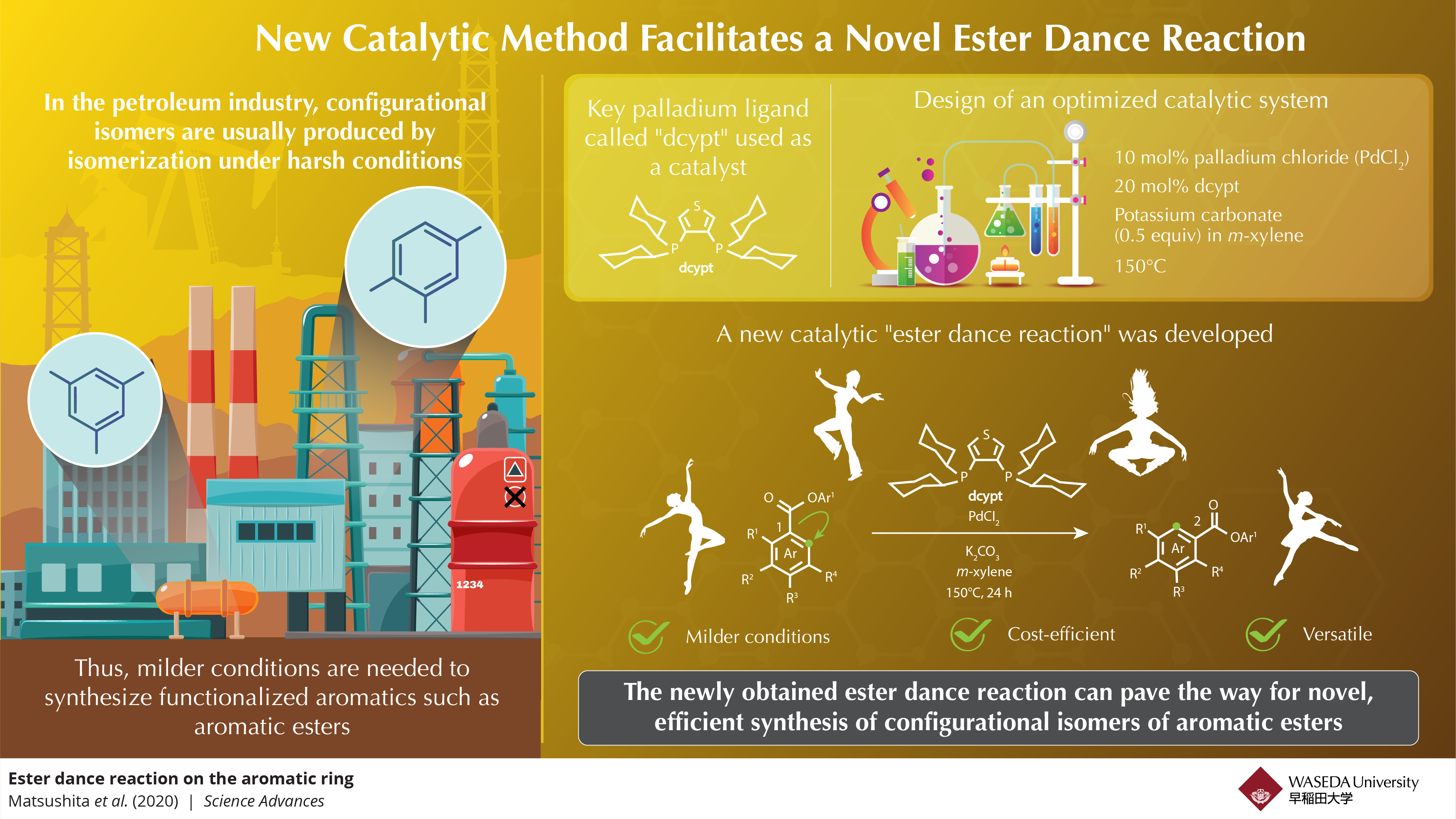Dancing chemicals: Innovative catalytic reaction for low-cost synthesis of aromatic esters
Tue, Jul 14, 2020-
Tags
Dancing chemicals: Innovative catalytic reaction for low-cost synthesis of aromatic esters
Scientists discover a novel “ester dance reaction” that can pave the way for various developments in organic chemistry

IMAGE: A NEW, PRACTICAL CATALYTIC REACTION, CALLED THE “ESTER DANCE REACTION, ” TO ACHIEVE A HIGH YIELD OF AROMATIC ESTERS FROM LOW-COST STARTING MATERIALS. CREDIT: JUNICHIRO YAMAGUCHI (WASEDA UNIVERSITY)
Aromatic esters are chemicals that contain an aromatic ring consisting of functional groups called esters. These organic compounds are widely used as chemical feedstock in industries like food and beverages, pharmaceuticals, and cosmetics. Thus, finding efficient reactions for their synthesis is an important area of research in organic chemistry. In the petroleum industry, chemists use a unique reaction called aromatic isomerization for the synthesis of aromatic compounds, in which the functional group (mainly hydrocarbon) on the carbon atom in the starting material migrates to another carbon atom on the aromatic ring. But, this reaction requires harsh conditions, and thus, there are considerable doubts regarding its sustainability.
To overcome this limitation, researchers at Waseda University, Japan, led by Professor Junichiro Yamaguchi, attempted to produce fine-grade aromatic esters using milder reactions, in a study published in Science Advances. The scientists derived their inspiration from another reaction, called the halogen dance reaction, in which a halogen substituent is translocated to another carbon atom on the aromatic ring and is often used in total synthesis of complex natural products. They wanted to find out if a similar reaction could be developed for esters too. But, this was no mean feat, as it is not easy to make the ester group change its position from one ring carbon to another under mild conditions. Luckily, the researchers’ previous experiments with ester transformation reactions had revealed that this was possible, although this reaction was not yet optimized. Yamaguchi says, “During our recent efforts in the development of decarbonylative transformations of aromatic esters, we unexpectedly discovered an aromatic compound with ester translocated from one carbon to another carbon. After optimizing the conditions, we were able to develop a new reaction, which we discovered by chance.”
The trick to developing this new reaction was a palladium catalyst consisting an easy-to-handle diphosphine ligand called dcypt, developed by the scientists. When the scientists tested this new catalyst, they were surprised by the reaction, which resulted in the ester group successfully being translocated on the aromatic ring–a finding that was unprecedented. The researchers named the process as “ester dance reaction,” owing to the ability of ester groups to “dance” around the aromatic ring. Discussing their achievement, Yamaguchi says, “In one of our experiments involving transformations of aromatic esters, we found that our ‘home-made’ catalyst can enable a difficult conversion reaction. This was an exciting new discovery.”
The researchers then went on to optimize the conditions for this reaction, in an effort to make it as efficient as possible. At first, the product was obtained at a low yield. But the researchers did not give up. Their experiments found appropriate concentrations of a palladium salt, dcypt, and a chemical reagent called potassium carbonate under optimal conditions, which resulted in a product yield as high as 85%. They also found that these three reagents were critical for the reaction to occur. With these optimized reaction conditions, the scientists explored this new ester dance reaction in other aromatic substances, such as phenyl benzoates, heteroarenes, and other aromatics. They found that combining this reaction with other ester-transforming reactions, such as arylation, amination, and etherification, produced compounds with an array of different substitution patterns. Interestingly, some derivatives of the products were much costlier than the starting material, meaning that this was an overall cost-efficient process. Furthermore, they successfully obtained a 1,3-translocation product to demonstrate a combination of the double ester dance and decarbonylation.
With the novel catalyst developed by the researchers and the optimized catalytic reaction, synthesizing aromatic compounds sustainably can now become easier. Yamaguchi concludes, “We believe that our unconventional yet predictable approach of using the ‘ester dance reaction’ will help the organic chemist synthesize aromatic compounds that are usually difficult and expensive to create.”
###
Reference
Authors: Kaoru Matsushita, Ryosuke Takise, Kei Muto, Junichiro Yamaguchi
Title of original paper: Ester dance reaction on the aromatic ring
Journal : Science Advances
DOI: https:/
Affiliations: Department of Applied Chemistry, School of Advanced Science and Engineering, Waseda University














